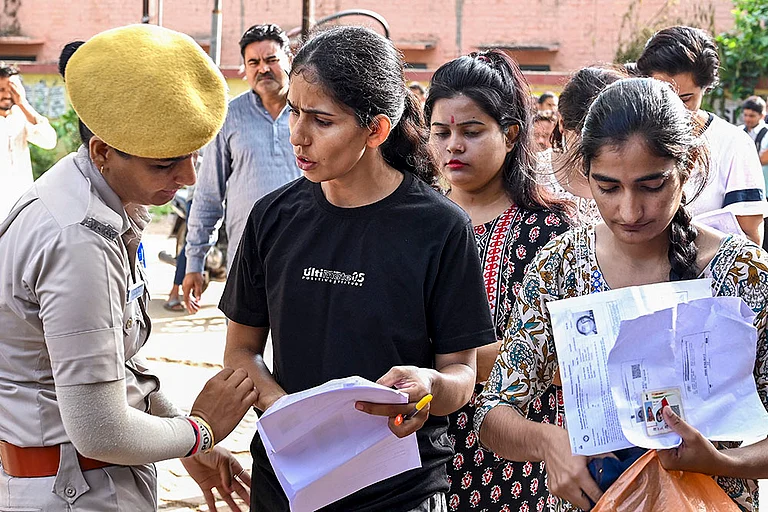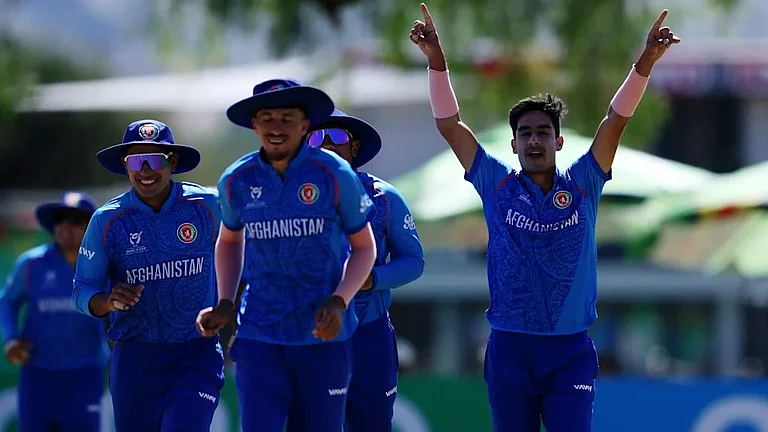It was a script written in blue, to be played out in front of 130,000 adoring fans at the priciest cricket stadium in the world, with a billion more, indeed perhaps almost every Indian, watching on television. The country was at a standstill for the coronation of a team as the World Champions of cricket, which seemed to have every rightful claim to it – a defining moment in the lives of this generation of cricketers, most of whom will probably not be there when the next edition of the World Cup comes around, four years later. India had won ten matches on the trot and victory seemed fated in front of this huge, expectant audience, looking forward to celebrating one of the most unforgettable days of their lives. (As It Happened | Scorecard | Pics | Full Coverage)
Only, the great barrier of Australia lay in between them and that dream. A barrier that they had failed to breach at the ICC World Test Championship final earlier this year and a barrier that had vowed to ‘silence 130,000 fans.’
That is exactly what they did last night, as this fantastic Indian team, which had not lost a single match over a phenomenal tournament, sunk with the hopes and aspirations of one and a half billion Indians who had put their lives on hold, to watch.
Also Read: Dravid Needs Time To Think On Future
Forty-eight matches done and dusted, back to back, crisscrossing the length and breadth of a huge country, over 42 days. A World Cup organised seamlessly, with the same clinical efficiency with which the Indian team was winning its matches. A huge tournament going off almost without a single glitch, be it in hospitality, travel, logistics or anything else, a fact that has been readily acknowledged by many a visiting player. Thanks to the sterling efforts of the unheralded backroom boys working behind the scenes, with their unmatched administrative, logistical and mega sports event management skills.
Surely that is something to be proud of as well.

The Indian team had been professionally clinical in everything that they did in this World Cup, up until the final, right from the way they played and executed their pre-match plans to their sheer determination and commitment to winning. Virat Kohli, Rohit Sharma, KL Rahul, Shreyas Iyer, Mohammed Shami, Jasprit Bumrah, Mohammed Siraj, Ravindra Jadeja, and Kuldip Yadav have all been such stars of this tournament. The highest run-getter by a mile, and his number two; the highest wicket-taker, the highest number of wins, the highest number of five-wicket hauls by a bowler – it was all from India. Over the month-and-a-half-long tournament, they seldom put a foot wrong, dominating as no other Indian team has done in the past, starting from that very first group match against Australia.
Till the final Sunday, when 130,000 fans in blue thronged the Narendra Modi Stadium in a 'Blue Carnival' of joy. Unfortunately, the script went wrong and destiny was not to be.
ALSO READ: The English Implosion
Australia had started badly in the tournament with two straight losses in the first two games to India and South Africa and their World Cup dreams hung by a slender thread. In an important group match against New Zealand, they barely managed to squeeze home by five runs in the final over of the game.
In the match against Afghanistan, they were down and out at 91 for 7 chasing 291, and only got home because of an astounding double hundred by Glenn Maxwell who played an innings that will be remembered for many, many years in World Cup history, as one of the greatest ever. Comparable in every way to the 175 by Kapil Dev against Zimbabwe in 1983, to rescue India from the depths of 17 for 5 and win the game for his country. Like that innings did for India 40 years ago, this knock by Maxwell galvanized the Australians into a unit that started to believe in their greatness and ability to recover from any situation.
And the team started to peak exactly at the right time.
Also Read: Legends React To Australia's Win Over India
They won a remarkable nine consecutive games on the trot after their defeats in the first two matches. India on the other hand, won ten games consecutively and had just one bad day in the entire tournament. Unfortunately, that came in the final against the one team that looked capable of stopping their dream run, and it was enough to push them into second place. They had looked invincible, much like the all-conquering West Indies sides of the 1975 and ’79 World Cups, and stood head and shoulders above their opponents in every match that they played, including the semi-final against New Zealand.
But Australia had answers to all questions asked of them in the final. They had a plan for this game and for every Indian player, which they executed to perfection. While for once, India floundered with their execution after their by-now customary flying start and came under pressure for the first time, in front of a huge home crowd that had turned out to see a famous Indian victory.

Despite all the professionalism and efficiency and the marvellous cricket on display, however, some sections of the foreign media seemed determined to find conspiracy and corruption at every turn. Stories about the bad outfield at Dharamsala, air pollution in Delhi and pitch swaps at Wankhede outweighed the joy that these matches brought and the heartwarming stories of fightbacks and courage that emerged from them. Especially from teams like Afghanistan who registered victories against three former World Cup champions, and to a lesser extent, the Netherlands, who defeated South Africa. Or the emergence of a new star from New Zealand, who traced his roots to India – Rachin Ravindra.
This negativity perhaps emanated from a struggle to come to terms with the power and financial clout that India now enjoys in world cricket, in addition to its magnificent performances on the field. But, other than being in bad taste and speaking poorly of the people who perpetrated it, the team achieved little else.
Cricket is now increasingly centred in the country where the most number of people play, love, live and breathe the sport. It also brings in the biggest contributions to the game, not just in the much-talked about, much-maligned material terms, but also in terms of the sheer love and passion for the sport, that is so important in keeping it alive and well.
Also Read: We Were Not Good Enough, Says Rohit Sharma
In India, it keeps a billion hearts beating and puts a smile on the faces of a population struggling with the after-effects of war in neighbouring Afghanistan, a nation that we will surely hear a lot more of in cricketing terms, soon. It’s the same in the other neighbouring countries as well, which makes you wonder whether that happiness and enjoyment, symbolised by the West Indies in the ‘70s, would still not be the single biggest reason for a country to do well in this sport.
Across the tournament India has showcased the perfect model for 50-over batting, with their top six batters all being very technically strong players whose games are built around the classical tenets of being well-balanced, moving forward and back well and presenting the full face of the bat at most times. The top five averaged an astonishing 67.63 in the group games – nobody else came close, with Australia averaging a distant 39.48, which proved the efficacy of these traditional methods in 50-over cricket. But, Glenn Maxwell in that unforgettable innings, also showed that there is another way, with his amazing hand-eye coordination, arm and core strength and incredible bat speed that allowed him to keep hitting sixes when struck by severe cramps, rendering him almost unable to move his legs. His method, with feet planted wide apart, and bat raised, like a baseball hitter, is probably the future of white ball hitting in the days to come.
This brings us the best Indian pace-attack we have ever seen.

There was a lot of talk about slow, low Indian wickets and high-scoring matches, and how hard it would be for the fast bowlers. But, the best in the world have all managed to be as menacing here, as anywhere else. Mohammed Shami, Jasprit Bumrah and Mohammed Siraj are definitely amongst the very best at this time and they consistently made early inroads into the opposing team’s top order. This happened even in the final before Travis Head and Marnus Labuschagne took the game away. In the past India lacked good quality pace bowlers and relied heavily on spin – today we still have quality spinners and our pace bowlers are amongst the best in the world.
This is an amazing achievement, considering that we still play most of our cricket on our slow, slogging wickets.
Finally, the intent shown by Rohit Sharma in his innings against the eventual champions, was great in the beginning, as he got India off to yet another flier when the ball was new and hard and coming onto the bat. But, his untimely departure in a Glenn Maxwell over where he had already hit a six and a four, put too much pressure on the rest of the batting, perhaps avoidably so. If only the skipper who scored 597 runs, the most runs ever by a captain in a World Cup, had batted a little longer in the final when he was going so well, who knows whether there would have been a different story to tell.
But as things happened, Travis Head, the man who took the World Test championship away from India in England, held on to a spectacular catch running back, much like Kapil Dev’s catch in the 1983 final, and then went on to take away the World Cup from the hosts, with yet another brilliant hundred.
With it, he took away the fondest dreams of an entire nation.
Life will go on, and there will be other matches to play and win, this is too good a team not to, and the country will get over this in time. But, for now, it’s back to the drawing board again for Team India. And a wait of four long years before the country can have another shot at winning a World Cup.
The views and opinions expressed are those of the author. The author is a veteran Wing Commander of the Indian Air Force, who has played Ranji Trophy for Services.


























